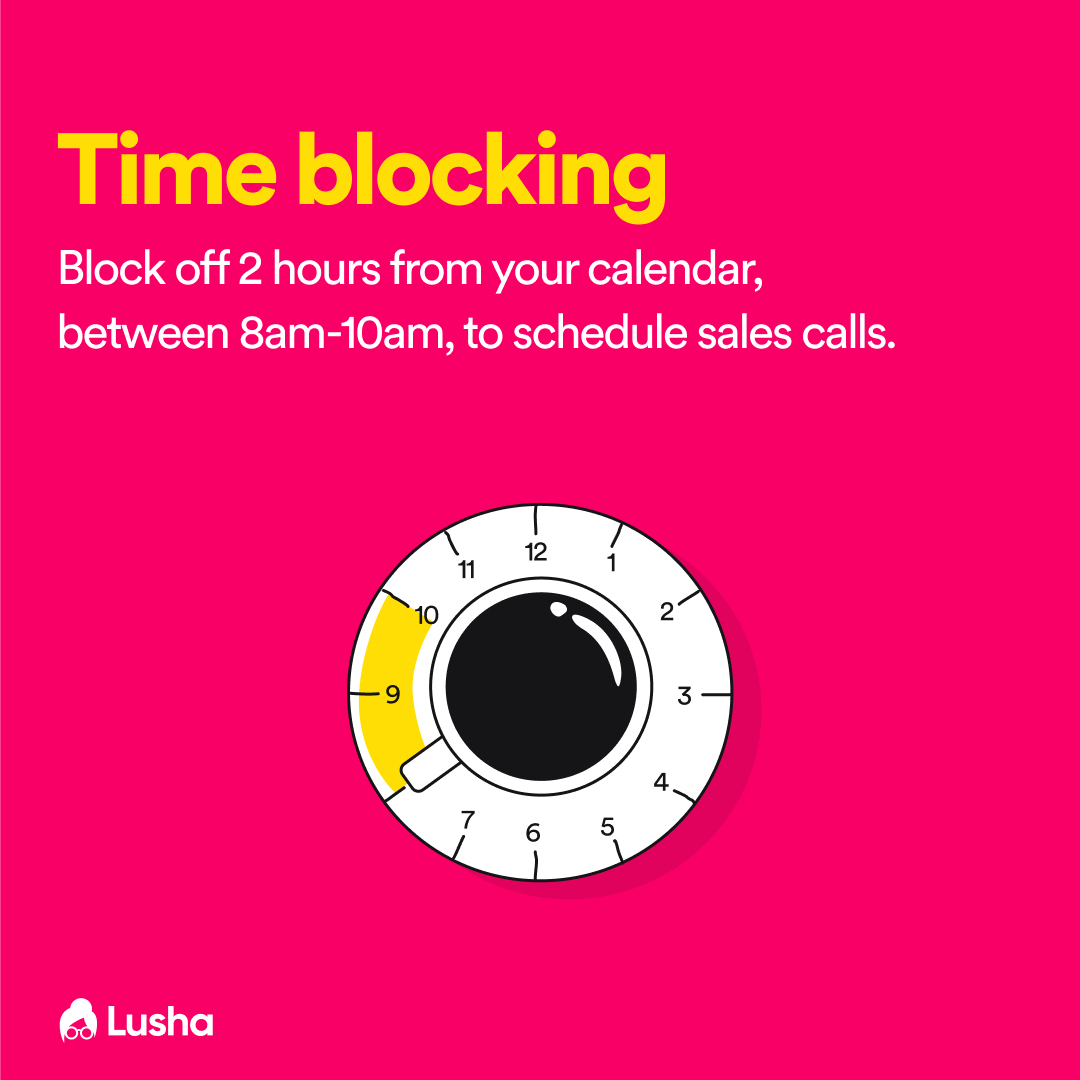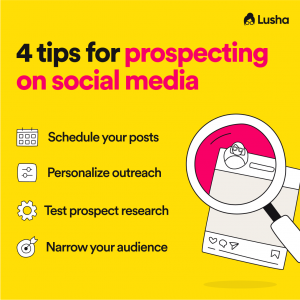If you think prospecting is the hardest part of your job, you’re not alone. Over 40% of all salespeople agree that it’s the most difficult part of the entire sales process (followed closely by closing and qualifying).
The trick is to diversify your prospecting process, activities, and skills to maximize the number of quality leads you’re sourcing. Sound tough? Don’t worry, we’ll guide you through best practices in sales prospecting and transform the most challenging part of your day into a smooth sales prospecting plan.
1. Use emotional triggers
Tapping into your target buyers’ reputation, power, and fears is a best practice in sales prospecting. On the podcast INSIDE Inside Sales, Benjamin Dennehy (the UK’s self-proclaimed “most hated trainer”) speaks about seeing salespeople stuck on the never-ending hamster wheel of prospecting: trapped in the preparation phase, never building up enough of an emotional connection before pitching to their prospect. They under-research and don’t have enough material to make a strong, hyper-personalized outreach message.
Use emotional triggers to escape the endless cycle of preparation and move on to receiving engagement through marketing channels and book meetings.
Common emotional triggers used in sales
Decision-makers make rational choices, but they are also human and will make purchasing decisions based on emotional triggers like:
- FOMO (fear of missing out)
Example: Most companies in your industry are already using influencer marketing and are seeing an increase in sales; are you looking to train your marketing team?
- FOMO (fear of missing out)
- Status
Example: Is your office furniture outdated? We have furniture to make you look more professional
- Status
- Time
Example: Instead of spending hours uploading files to your database manually, use our service and get back more time in your work day.
- Time

2. Get contact details and company intel together with a prospecting tool
Are you using multiple prospecting tools just to get the basic contact details and firmographics for one lead? Are you currently using multiple email finder extensions, verification tools, and company insights platforms? Then stop.
Lusha is going to make your sales prospecting so much easier. Our accurate B2B contact provider gives you the exact details and firmographics you need to qualify prospects, craft a personalized sales pitch, and write a memorable cold call script. Whether you’re prospecting on Linkedin, B2B websites, or Gmail, Lusha will give you direct email addresses, cell phone numbers – and important company intel like revenue, industry, and location. Then you can cut any manual errors and stay ahead of the prospecting game by saving all your contacts and this juicy info directly to your CRM.
3. Keep your pipeline fresh and full with the ‘30-day rule’
How do you know if your sales pipeline will be full three months from today? Take a look at your efforts from the last 30 days. If you’ve failed to bring in qualified leads or prospects regularly, you already know your answer. In the book Fanatical Prospecting, Jeb Blount describes his ‘30-day rule’: prospect for thirty days and you’ll see the results (aka sales) within the next three months.
It makes sense. SDRs are under more pressure than ever to close the deal as soon as possible – despite the fact that even the smallest B2B sales cycles can take up to four months (and larger ones seven months or more). Missing even a single week of prospecting can put a huge dent in your quarterly revenue. Hunting for new business opportunities daily, even when your pipeline is full, is a best practice in B2B sales prospecting.
4. Prospect daily with time-blocking
The idea behind time blocking is pretty simple: schedule a task to be completed within a certain time period. For example, to increase your cold call connection rates, you may want to schedule your calls between 8 am and 10 am. Then that daily two-hour block is reserved exclusively for making outbound calls.
Use time blocking to prioritize your high-value tasks and responsibilities towards the beginning of the day, to ensure activities like sales prospecting are knocked off your to-do list before anything else.
Make the most of every minute
Once you have blocked off a couple of hours for solid prospecting, be sure to use it! Here are three things to remember:
- Focus solely on prospecting. Don’t give in to notifications or other distractions that will pull you away from prospecting. If everything has its own time slot, there’s no need to even think about answering an email or checking your phone.
- Prioritize your lead list. Some leads on your prospecting list are more difficult to qualify or find contact details for. Place them on the back burner and concentrate your efforts on gathering as many qualified leads and contact details as possible.
- Schedule both deep and shallow tasks. Prospecting isn’t just researching: it’s making a connection, creating or sharing content, and writing cold email templates. Make time for both big and small tasks.

5. Look closer to home
Another of the best practices in sales prospecting is to look for new business internally. Old leads that haven’t converted into sales may still be valuable to you. Take a look at who’s stuck in the funnel and dust off those relationships.
Before you start looking, see if they still qualify by using a bulk-enrichment tool that will provide the contact details and firmographics of thousands of leads and company profiles sitting in your CRM. Even if it’s been years since you last connected, you’ll get updated information to make sure you’ve got everything you need to reach out again.
6. Focus on quality of prospects, not quantity
One of the most important things to remember is that prospecting is a quality-over-quantity game. As much as you might want to fill up your pipeline with high numbers of prospects, you have to make sure to do it right.
Don’t waste time focusing your prospecting efforts on chasing uninterested people. Remember that the prospect comes before prospecting, so the trick is to figure out exactly who fits that profile of the ideal customer for your company.
It takes some time to find that perfect glass slipper fit, so start by analyzing current customers and understanding what it is about them that makes them the ideal customer. Develop ideal customer profiles (ICP’s) and use them to source ideal prospects. You should be thinking about these key ICP qualities when identifying your perfect prospects:
- Budget/revenue: Can the prospects’ company afford your product? What’s the lowest price threshold that your prospect would need to pay?
- Industry vertical: What verticals do you work with? Which ones do you not?
- Company size: What size companies are your ICP from?
- Legality: is your potential customer base limited by legal reasons such as location, age, or government restrictions?

7. Create a stronger lead qualifying system
The most important sales prospecting strategy is lead qualification. When you qualify leads, you prevent bad apples from entering your pipeline and clogging it up. A great lead enrichment tool will provide accurate firmographics and demographics on your leads so you can decide who should move down your pipeline.
It’s also important to establish a comprehensive lead-scoring system between your marketing and sales teams if you plan to use an inbound strategy. If the two teams don’t agree, then marketing might send over unqualified leads to sales reps, who then have to spend more time qualifying them further. Both marketing and sales need to know exactly what their ideal customer looks like and what the threshold is for sending leads over to the sales team.
8. Heat those cold calls up
Everyone’s always asking if the cold call is dead, but the truth is it’s still kicking. Whether you like it or not, cold-calling is an effective way to source new prospects. In fact, 82% of buyers say they have accepted meetings with salespeople after a series of contacts beginning with sales cold calls.
Cold calls are all about expediting the process of going from complete strangers to trusted colleagues in a matter of minutes. Scared to take the plunge into freezing cold call water? Do your research on the company and prospect beforehand so that once you get through to a decision-maker, you’ll be able to demonstrate the value of your product to that particular company and build trust. To give you an extra boost in turning that cold call into warm outbound, try out Lusha’s Intent signals to see whether a company is actively searching for solutions like yours. Using a number of signals from all over the web, we help you track levels of interest in relevant topics. Then, you can wow your prospects by bringing up the exact pain point they’ve been googling.
9. Become a thought leader
Who knows more about a product than someone trying to sell it? Nobody, which is why thought leadership is a fantastic sales prospecting method. Build credibility and trust with your prospects by sharing what you know. This way, you increase your chances of a prospect already knowing about you and learning from you before you even make initial contact. This means you’ll no longer be a stranger, but someone smart and credible that they are already familiar with.
The easiest and most popular way to do this is by posting regularly on LinkedIn, the biggest platform for B2B.
Decision-makers want to read content that takes a stance, is thought-provoking, challenges their ideas about their industry, and gets them worked up (in a good way). Besides using Sales Navigator to look for potential customers, you could use LinkedIn to build your reputation as thought leaders within your industry.
Becoming a thought leader is valuable for customer journey optimization. It gives you the opportunity to engage prospects at every stage in your funnel with content your competitors don’t have because every insight is completely unique.
According to one LinkedIn study, 58% of sales teams producing thought leadership content say it drives awareness and contributes to their top-of-the-funnel strategy. 86% of decision-makers say they’ve become aware of a company because of thought leadership content. If you implement this strategy when it’s time to reach out to new leads, contacts will already be familiar with you and your product or service, which helps warm them up to your pitch.
10. Social media is a must
Speaking of LinkedIn…we hate to break it to you but if you’re not squeezing as much juice out of your social media platforms as possible, then your sales prospecting methods are probably not up to scratch. Social media and prospecting go hand-in-hand, since it’s a great place to find, research, and interact with prospective customers.
Follow these 4 tips for prospecting on social media:
- Schedule your posts. Create an ongoing schedule for all your social media posts; consistency is the key here.
- Personalize your outreach. Create templates that make personalizing your outreach messages easier.
- Test, test, and test again. Test how best to find your prospects on different social media channels using different filters. There is no one-size-fits-all approach.
- Less is more. Narrow your target audience down using filters such as job role, geographic location, and more.

11. Use your expertise to answer Q&A forums
Participating in online forums such as Quora, Reddit, Facebook Groups, and LinkedIn Groups is a fantastic way to find prospects. These forums allow you to educate your audiences on best practices from within your industry and educate them on your product. By joining these platforms and reading the forums, you’ll get to know a lot more about your prospects and their pain points.
Once you’re ready, start chiming in on some conversations and answer questions. Be sure to leave some sort of next step at the end of your answer. For example, if someone asks “How can I improve my sales prospecting methods?”, you could answer with five methods from a blog post you wrote, then link the readers to your blog post to read the rest. This is going to generate more traffic to your site and help you source more qualified prospects.
12. Ask for referrals
Referrals are one of the most reliable sales prospecting methods, so take full advantage. Sales pros know that referrals are the fastest revenue driver and solve two major issues: getting those qualified leads into the pipeline and getting decision-makers into a meeting.
So why are referrals such a fire prospecting method? Well, we all know that sales are about building trust between a salesperson and a prospect.
A staggering 92% of people will trust referrals from people they know. Referrals build confidence between salesperson and prospect, which means that a prospect will probably move through the sales pipeline faster. Plus with referrals, prospects expect to hear from you, so they’re already warmed up and ready to take the call– making your job easier because you’re not a complete stranger.
So don’t be too shy to ask your favorite happy customers for referrals, and don’t forget to say thank you to the MVP who referred you.
13. Keep following up
Following up is one of the most important B2B sales prospecting methods to make sure a potential customer doesn’t fall through the cracks. Be sure to always keep your prospect in the loop by following up at each step of the sales cycle. This could be anything from sending over resources to confirming the next meeting.
The key to following up is persistence. 44% of all salespeople give up after just one follow-up! While we’re not saying you should stalk your prospect and call them 10 times a day, we also don’t want you to give up after one unanswered call. Set up a cadence that works for you and stick to it. We also recommend setting aside a good chunk of time every day to focus on only follow-ups so you won’t forget to do it.
14. Remember prospecting never ends
We know it sounds a bit daunting, especially because prospecting is one of the hardest parts of your job in sales. But it’s important to remember that sales prospecting is an ongoing prospect and not just a one-off event. You need to carve out time each day for it.
Prospecting isn’t over after the first phone call; you need to stay persistent and keep going. Plus, you should be constantly researching and updating your prospecting methods. Changes to social media and technology happen all the time, and new best practices pop up frequently, so keep your finger on the pulse and be open to the ever-evolving world of sales prospecting.
Wrapping Up
We hope you found these sales prospecting best practices, tips, methods, and techniques helpful, and that you’re feeling confident enough to get out there and kick your prospecting game into high gear. We know we dropped a lot of prospecting best practices on you at once– if you’re a little lost, start by implementing the easiest bit of advice and try out Lusha for free.

